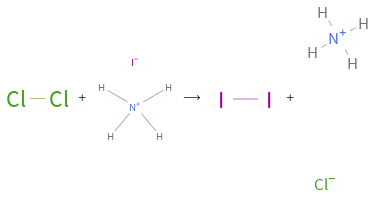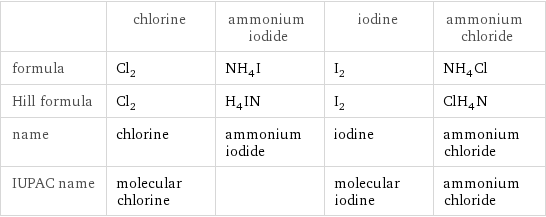Input interpretation

Cl_2 chlorine + NH_4I ammonium iodide ⟶ I_2 iodine + NH_4Cl ammonium chloride
Balanced equation

Balance the chemical equation algebraically: Cl_2 + NH_4I ⟶ I_2 + NH_4Cl Add stoichiometric coefficients, c_i, to the reactants and products: c_1 Cl_2 + c_2 NH_4I ⟶ c_3 I_2 + c_4 NH_4Cl Set the number of atoms in the reactants equal to the number of atoms in the products for Cl, H, I and N: Cl: | 2 c_1 = c_4 H: | 4 c_2 = 4 c_4 I: | c_2 = 2 c_3 N: | c_2 = c_4 Since the coefficients are relative quantities and underdetermined, choose a coefficient to set arbitrarily. To keep the coefficients small, the arbitrary value is ordinarily one. For instance, set c_1 = 1 and solve the system of equations for the remaining coefficients: c_1 = 1 c_2 = 2 c_3 = 1 c_4 = 2 Substitute the coefficients into the chemical reaction to obtain the balanced equation: Answer: | | Cl_2 + 2 NH_4I ⟶ I_2 + 2 NH_4Cl
Structures

+ ⟶ +
Names

chlorine + ammonium iodide ⟶ iodine + ammonium chloride
Reaction thermodynamics
Gibbs free energy

| chlorine | ammonium iodide | iodine | ammonium chloride molecular free energy | 0 kJ/mol | -112.5 kJ/mol | 0 kJ/mol | -202.9 kJ/mol total free energy | 0 kJ/mol | -225 kJ/mol | 0 kJ/mol | -405.8 kJ/mol | G_initial = -225 kJ/mol | | G_final = -405.8 kJ/mol | ΔG_rxn^0 | -405.8 kJ/mol - -225 kJ/mol = -180.8 kJ/mol (exergonic) | | |
Equilibrium constant
![Construct the equilibrium constant, K, expression for: Cl_2 + NH_4I ⟶ I_2 + NH_4Cl Plan: • Balance the chemical equation. • Determine the stoichiometric numbers. • Assemble the activity expression for each chemical species. • Use the activity expressions to build the equilibrium constant expression. Write the balanced chemical equation: Cl_2 + 2 NH_4I ⟶ I_2 + 2 NH_4Cl Assign stoichiometric numbers, ν_i, using the stoichiometric coefficients, c_i, from the balanced chemical equation in the following manner: ν_i = -c_i for reactants and ν_i = c_i for products: chemical species | c_i | ν_i Cl_2 | 1 | -1 NH_4I | 2 | -2 I_2 | 1 | 1 NH_4Cl | 2 | 2 Assemble the activity expressions accounting for the state of matter and ν_i: chemical species | c_i | ν_i | activity expression Cl_2 | 1 | -1 | ([Cl2])^(-1) NH_4I | 2 | -2 | ([NH4I])^(-2) I_2 | 1 | 1 | [I2] NH_4Cl | 2 | 2 | ([NH4Cl])^2 The equilibrium constant symbol in the concentration basis is: K_c Mulitply the activity expressions to arrive at the K_c expression: Answer: | | K_c = ([Cl2])^(-1) ([NH4I])^(-2) [I2] ([NH4Cl])^2 = ([I2] ([NH4Cl])^2)/([Cl2] ([NH4I])^2)](../image_source/093e5a6a5915aca7fccb1dd3a173de06.png)
Construct the equilibrium constant, K, expression for: Cl_2 + NH_4I ⟶ I_2 + NH_4Cl Plan: • Balance the chemical equation. • Determine the stoichiometric numbers. • Assemble the activity expression for each chemical species. • Use the activity expressions to build the equilibrium constant expression. Write the balanced chemical equation: Cl_2 + 2 NH_4I ⟶ I_2 + 2 NH_4Cl Assign stoichiometric numbers, ν_i, using the stoichiometric coefficients, c_i, from the balanced chemical equation in the following manner: ν_i = -c_i for reactants and ν_i = c_i for products: chemical species | c_i | ν_i Cl_2 | 1 | -1 NH_4I | 2 | -2 I_2 | 1 | 1 NH_4Cl | 2 | 2 Assemble the activity expressions accounting for the state of matter and ν_i: chemical species | c_i | ν_i | activity expression Cl_2 | 1 | -1 | ([Cl2])^(-1) NH_4I | 2 | -2 | ([NH4I])^(-2) I_2 | 1 | 1 | [I2] NH_4Cl | 2 | 2 | ([NH4Cl])^2 The equilibrium constant symbol in the concentration basis is: K_c Mulitply the activity expressions to arrive at the K_c expression: Answer: | | K_c = ([Cl2])^(-1) ([NH4I])^(-2) [I2] ([NH4Cl])^2 = ([I2] ([NH4Cl])^2)/([Cl2] ([NH4I])^2)
Rate of reaction
![Construct the rate of reaction expression for: Cl_2 + NH_4I ⟶ I_2 + NH_4Cl Plan: • Balance the chemical equation. • Determine the stoichiometric numbers. • Assemble the rate term for each chemical species. • Write the rate of reaction expression. Write the balanced chemical equation: Cl_2 + 2 NH_4I ⟶ I_2 + 2 NH_4Cl Assign stoichiometric numbers, ν_i, using the stoichiometric coefficients, c_i, from the balanced chemical equation in the following manner: ν_i = -c_i for reactants and ν_i = c_i for products: chemical species | c_i | ν_i Cl_2 | 1 | -1 NH_4I | 2 | -2 I_2 | 1 | 1 NH_4Cl | 2 | 2 The rate term for each chemical species, B_i, is 1/ν_i(Δ[B_i])/(Δt) where [B_i] is the amount concentration and t is time: chemical species | c_i | ν_i | rate term Cl_2 | 1 | -1 | -(Δ[Cl2])/(Δt) NH_4I | 2 | -2 | -1/2 (Δ[NH4I])/(Δt) I_2 | 1 | 1 | (Δ[I2])/(Δt) NH_4Cl | 2 | 2 | 1/2 (Δ[NH4Cl])/(Δt) (for infinitesimal rate of change, replace Δ with d) Set the rate terms equal to each other to arrive at the rate expression: Answer: | | rate = -(Δ[Cl2])/(Δt) = -1/2 (Δ[NH4I])/(Δt) = (Δ[I2])/(Δt) = 1/2 (Δ[NH4Cl])/(Δt) (assuming constant volume and no accumulation of intermediates or side products)](../image_source/f8423c6dcdc0bdf663c9be6576970db3.png)
Construct the rate of reaction expression for: Cl_2 + NH_4I ⟶ I_2 + NH_4Cl Plan: • Balance the chemical equation. • Determine the stoichiometric numbers. • Assemble the rate term for each chemical species. • Write the rate of reaction expression. Write the balanced chemical equation: Cl_2 + 2 NH_4I ⟶ I_2 + 2 NH_4Cl Assign stoichiometric numbers, ν_i, using the stoichiometric coefficients, c_i, from the balanced chemical equation in the following manner: ν_i = -c_i for reactants and ν_i = c_i for products: chemical species | c_i | ν_i Cl_2 | 1 | -1 NH_4I | 2 | -2 I_2 | 1 | 1 NH_4Cl | 2 | 2 The rate term for each chemical species, B_i, is 1/ν_i(Δ[B_i])/(Δt) where [B_i] is the amount concentration and t is time: chemical species | c_i | ν_i | rate term Cl_2 | 1 | -1 | -(Δ[Cl2])/(Δt) NH_4I | 2 | -2 | -1/2 (Δ[NH4I])/(Δt) I_2 | 1 | 1 | (Δ[I2])/(Δt) NH_4Cl | 2 | 2 | 1/2 (Δ[NH4Cl])/(Δt) (for infinitesimal rate of change, replace Δ with d) Set the rate terms equal to each other to arrive at the rate expression: Answer: | | rate = -(Δ[Cl2])/(Δt) = -1/2 (Δ[NH4I])/(Δt) = (Δ[I2])/(Δt) = 1/2 (Δ[NH4Cl])/(Δt) (assuming constant volume and no accumulation of intermediates or side products)
Chemical names and formulas

| chlorine | ammonium iodide | iodine | ammonium chloride formula | Cl_2 | NH_4I | I_2 | NH_4Cl Hill formula | Cl_2 | H_4IN | I_2 | ClH_4N name | chlorine | ammonium iodide | iodine | ammonium chloride IUPAC name | molecular chlorine | | molecular iodine | ammonium chloride
Substance properties

| chlorine | ammonium iodide | iodine | ammonium chloride molar mass | 70.9 g/mol | 144.94 g/mol | 253.80894 g/mol | 53.49 g/mol phase | gas (at STP) | solid (at STP) | solid (at STP) | solid (at STP) melting point | -101 °C | 551 °C | 113 °C | 340 °C boiling point | -34 °C | | 184 °C | density | 0.003214 g/cm^3 (at 0 °C) | 2.51 g/cm^3 | 4.94 g/cm^3 | 1.5256 g/cm^3 solubility in water | | | | soluble dynamic viscosity | | | 0.00227 Pa s (at 116 °C) |
Units
